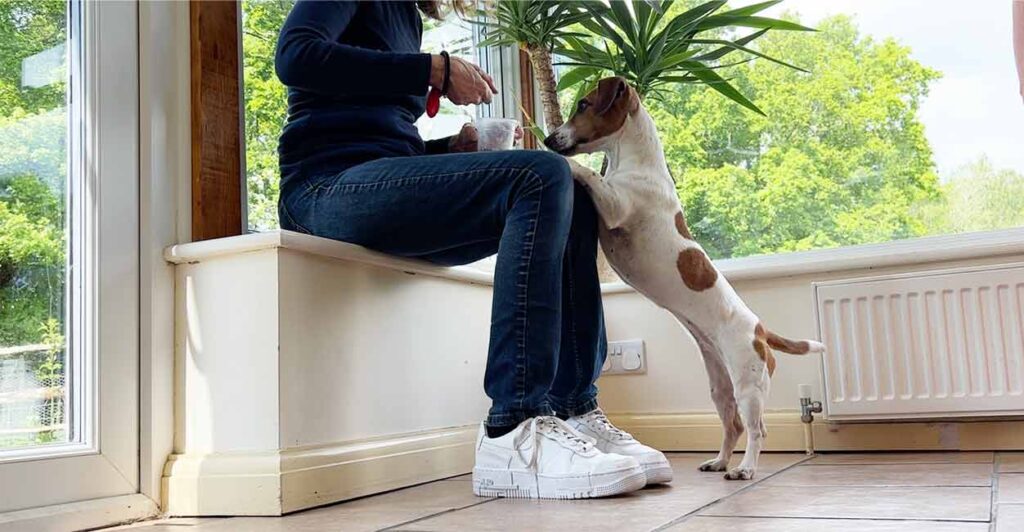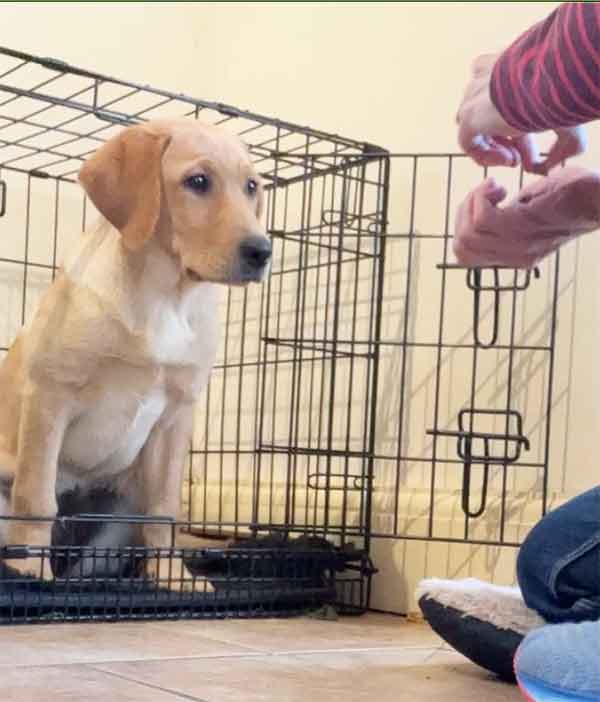I recommend hand feeding dogs in several of my courses and articles. And quite a few readers asked me to elaborate on this after my recent article on bonding with a rescue dog.

There are several reasons why you might want to consider hand feeding a dog, so we’ll take a look at those, and I’ll also give you some tips on going the right way about it.
What Do I Mean By ‘Hand Feeding’?
Strictly speaking, hand feeding means that what your dog eats goes straight from your hand to their mouth. It isn’t placed in a bowl and served up as ‘dinner’.
Typically, hand feeding involves breaking the dog’s daily ration into lots of small portions and feeding a few pieces of food at a time, followed by a break, then a few more pieces.

Hand feeding usually means feeding quite frequently and it helps if you wear a treat bag while you do this so that the food is available whenever you need it.
The hand fed food can be given without conditions, or it can be used as training treats. I use both approaches and I’ll talk a bit more about that below.
So why would you want to do this?
Reasons To Hand Feed Your Dog
The main reason to hand feed any dog or puppy is to build a connection with them. This could be because the dog is new to you. Or because your connection with that dog is insufficient for good progress in training. For example
- You have a new puppy
- You have rescued an older dog
- Your dog doesn’t pay attention to you
- Your dog has a poor recall
New Puppies
There are many benefits to hand feeding a new puppy, and as a general rule, when I buy a puppy, I hand feed nearly all of their food for their first few weeks with me.
New puppies are in a very stressful situation where everything familiar to them has been removed, and hand feeding helps form a bond or connection with new family members much more quickly than could be achieved by serving their food in a bowl.
It requires the puppy to focus on you and on what you are doing repeatedly, and helps to reassure them that you are a benevolent person that can be relied upon.
Hand feeding a puppy also helps to ensure that you can spend plenty of time engaging them in training games. Puppy food portions are quite small to begin with, and putting food down in a bowl really limits the allowance of food that you can devote to those games.
Rescue Dogs
With a rescue dog, the situation is similar in that they are feeling abandoned and lonely to begin with. Food is a great bonding tool for them.
Their need for reassurance may be even greater than a puppy’s because an adult dog is not primed to trust friendly humans in the way that an eight week old puppy is.
Hand feeding helps to build that trust and to kick start the long process of creating the special relationship that we all seek with our dogs.
Dogs That Don’t Listen
Many people get into a situation with older dogs where their dog clearly loves them and enjoys their company, but doesn’t listen to a word they say.
Commands are ignored, especially outdoors, and the dog has no interest in paying the owner any attention if there’s anything better to do. Particularly when it comes to recall.
Using food allowance up in training games, especially focus games, is a great way of creating a shift in your dog’s mindset and get them listening to you again. It also paves the way for structured training program to deal with issues such as recall
Dogs With Poor Recall
Dogs that won’t come when they are called are extremely vulnerable. Both to accidents, and to being abandoned in a rescue center or animal shelter.
If your dog has a poor recall, it really is imperative that you fix this promptly and the best way to start is with hand feeding repeatedly for attention and by associating a brand new recall cue with copious high value hand-fed treats. You can find a lot more information about recall training in my book: Total Recall.
How To Hand Feed Dogs Effectively
Obviously you could simply take a bowl of kibble and feed it one piece at a time to your dog.
But, just dishing out dog food, piece by piece is missing out on some great opportunities for shaping new and better behaviors. Instead you could use that food to reinforce behaviors that you want to encourage in your dog.
Where you start with this, depends on your existing relationship with your dog
Building Trust
Its possible that there are trust issues between you and your dog. Perhaps the dog is a rescue dog that doesn’t really know you.
Or perhaps you’ve used some methods in the past that make your dog wary of you, and you want to start over and rebuild that trust again.
If that’s the case then frequent hand feeding for simply approaching you or relaxing near you, is a great way to start. Don’t ask the dog for any behaviors they feel uncomfortable with at this point.
And if the dog is reluctant to take food out of your hand, drop it on the floor to begin with. You can progress to hand feeding as the dog grows more confident.
Changing Behavior
If your dog already knows you well and trusts you, then you get start straight away with some training games.
I’m not talking about complex training here. But rather looking out for simple behaviors that improve your dog’s overall ability to be a relaxing companion
These could be behaviors such as being quiet instead of barking, or giving you some eye contact. And they could be a simple as standing still rather than rushing around, or keeping all four paws on the floor instead of jumping up.
Don’t Miss Out
Each time you feed a dog you have an opportunity to strengthen your relationship with them. If your dog has just one meal a day. That’s 30 opportunities each month. But what if you hand feed ten or even twenty small portions of food a day during that month?
Now you are looking at 300 or even 600 opportunities. I’m sure you can see the significance and potential benefit there. And it’s those opportunities that you are missing, if you are a feed once a day kind of person.
Build A Better Bond
Some studies* have shown that dogs can recognize and remember people that are willing to share food with them.
After all, we all need to eat. Apart from during the small period of time when babies are being raised, sharing food is an unusual trait in animals, and doing so elevates your importance in your dog’s eyes.
Don’t miss out on any chances to build a better bond with your dog. Especially if you and your dog have ‘drifted apart’ lately.
You’ll be amazed how much your relationship can be improved simply by showing the dog that you are a worthwhile person to be around and to focus on, through the simple medium of sharing the most important resource in your dog’s life.
Did you hand feed your dog when they were small or newly adopted? Let us know in the comments below how that went for you.
References*
- Free ranging dogs quickly recognize a rewarding person, Nandi et al, Applied Animal Behavior Science 2024
- Social evesdropping in the domestic dog, Marshall-Pescini et al, Animal Behaviour 2011

Free Training Tips
Get Pippa's free dog training tips delivered to your inbox

 Bonding With Your Rescue Dog
Bonding With Your Rescue Dog